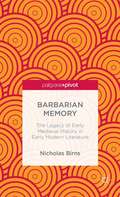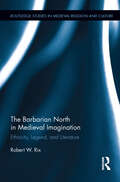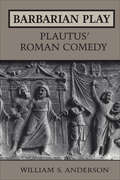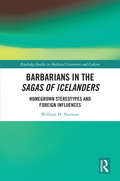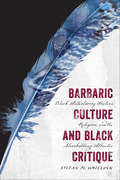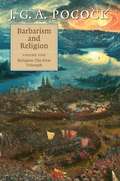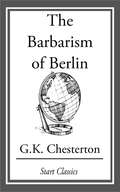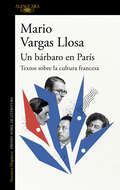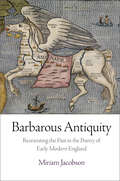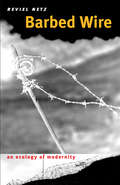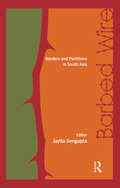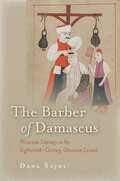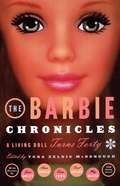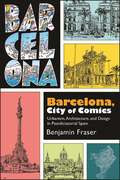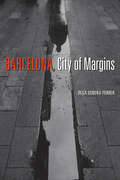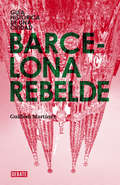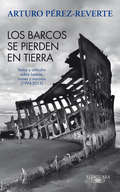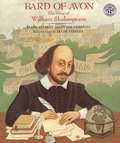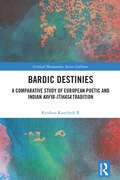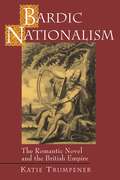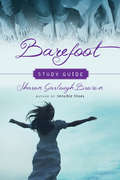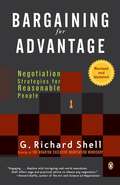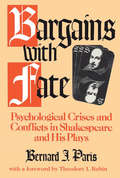- Table View
- List View
Barbara Wright
by Debra Kelly Madeleine RenouardLegendary publisher and writer John Calder said of Barbara Wright that she was "the most brilliant, conscientious and original translator of 20th century French literature." Wright introduced to an English-speaking readership and audience some of the most innovative French literature of the last hundred years: a world without Alfred Jarry's Ubu, Raymond Queneau's Zazie, and Robert Pinget's Monsieur Songe scarcely bears thinking about. This wonderful collection of texts about and by Barbara Wright--including work by David Bellos, Breon Mitchell, and Nick Wadley, as well as a previously unpublished screenplay written and translated by Wright in collaboration with Robert Pinget--begins the work of properly commemorating a figure toward whom all of English letters owes an unpayable debt.
Barbara Wright
by Debra Kelly Madeleine RenouardLegendary publisher and writer John Calder said of Barbara Wright that she was "the most brilliant, conscientious and original translator of 20th century French literature." Wright introduced to an English-speaking readership and audience some of the most innovative French literature of the last hundred years: a world without Alfred Jarry's Ubu, Raymond Queneau's Zazie, and Robert Pinget's Monsieur Songe scarcely bears thinking about. This wonderful collection of texts about and by Barbara Wright--including work by David Bellos, Breon Mitchell, and Nick Wadley, as well as a previously unpublished screenplay written and translated by Wright in collaboration with Robert Pinget--begins the work of properly commemorating a figure toward whom all of English letters owes an unpayable debt.
Barbarian Memory: The Legacy of Early Medieval History in Early Modern Literature
by Nicholas BirnsAn investigation of the use of Late Antique European history by late medieval and Renaissance writers such as Chaucer, Shakespeare, Davenant, Trissino, and Corneille. The liminality of the late antique period and the issues of ethnicity and religion it raises makes it very different from that of the classical world in analogous writers.
The Barbarian North in Medieval Imagination: Ethnicity, Legend, and Literature (Routledge Studies in Medieval Religion and Culture)
by Robert RixThis book examines the sustained interest in legends of the pagan and peripheral North, tracing and analyzing the use of an ‘out-of-Scandinavia’ legend (Scandinavia as an ancestral homeland) in a wide range of medieval texts from all over Europe, with a focus on the Anglo-Saxon tradition. The pagan North was an imaginative region, which attracted a number of conflicting interpretations. To Christian Europe, the pagan North was an abject Other, but it also symbolized a place from which ancestral strength and energy derived. Rix maps how these discourses informed ‘national’ legends of ancestral origins, showing how an ‘out-of-Scandinavia’ legend can be found in works by several familiar writers including Jordanes, Bede, ‘Fredegar’, Paul the Deacon, Freculph, and Æthelweard. The book investigates how legends of northern warriors were first created in classical texts and since re-calibrated to fit different medieval understandings of identity and ethnicity. Among other things, the ‘out-of-Scandinavia’ tale was exploited to promote a legacy of ‘barbarian’ vigor that could withstand the negative cultural effects of Roman civilization. This volume employs a variety of perspectives cutting across the disciplines of poetry, history, rhetoric, linguistics, and archaeology. After years of intense critical interest in medieval attitudes towards the classical world, Africa, and the East, this first book-length study of ‘the North’ will inspire new debates and repositionings in medieval studies.
Barbarian Play: Plautus' Roman Comedy
by William AndersonIn this volume William S. Anderson sets Plautus, who wrote Rome's earliest surviving poetry, in his rightful place among the Greek and Roman writers of what we know as New Comedy (fourth to second centuries). Anderson begins by defining major innovations that Plautus made on inherited Greek New Comedy (Menander, Philemon, and Diphilus), transforming it from romantic domestic drama to a celebration of rollicking family anarchy. He shows how Plautus diminished the traditional importance of love and replaced it with a new major theme: 'heroic badness,' especially embodied in the rogue slave (ancestor of the impudent servant, valet, or maid). Anderson then examines the unique verbal texture of Plautus' drama and demonstrates his revolt against realism, his drive to have his characters defy everyday circumstances and pit their intrepid linguistic wit against social order, their Roman extravagant impudence against Greek self-control. Finally, Anderson explores the special form of metatheatre that we admire in Plautus, by which he undermines the assumptions of his Greek 'models' and replaces them with a new, confident Roman comedy.
Barbarians in the Sagas of Icelanders: Homegrown Stereotypes and Foreign Influences
by William H. NormanThis book explores accounts in the Sagas of Icelanders of encounters with foreign peoples, both abroad and in Iceland, who are portrayed according to stereotypes which vary depending on their origins. Notably, inhabitants of the places identified in the sagas as Írland, Skotland and Vínland are portrayed as being less civilized than the Icelanders themselves. This book explores the ways in which the Íslendingasögur emphasize this relative barbarity through descriptions of diet, material culture, style of warfare and character. These characteristics are discussed in relation to parallel descriptions of Icelandic characters and lifestyle within the Íslendingasögur, and also in the context of a tradition in contemporary European literature, which portrayed the Icelanders themselves as barbaric. Comparisons are made with descriptions of barbarians in classical Roman texts, primarily Sallust, but also Caesar and Tacitus, showing striking similarities between Roman and Icelandic ideas about barbarians.
Barbaric Culture and Black Critique: Black Antislavery Writers, Religion, and the Slaveholding Atlantic
by Stefan M. WheelockIn an interdisciplinary study of black intellectual history at the dawn of the nineteenth century, Stefan M. Wheelock shows how black antislavery writers were able to counteract ideologies of white supremacy while fostering a sense of racial community and identity. The major figures he discusses--Ottobah Cugoano, Olaudah Equiano, David Walker, and Maria Stewart--engaged the concepts of democracy, freedom, and equality as these ideas ripened within the context of racial terror and colonial hegemony. Wheelock highlights the ways in which religious and secular versions of collective political destiny both competed and cooperated to forge a vision for a more perfect and just society. By appealing to religious sensibilities and calling for emancipation, these writers addressed slavery and its cultural bearing on the Atlantic in varied, complex, and sometimes contradictory ways during a key period in the development of Western political identity and modernity.
Barbarism and Religion: The First Triumph
by J. G. A. PocockThis fifth volume in John Pocock's acclaimed sequence on Barbarism and Religion turns to the controversy caused by Edward Gibbon's treatment of the early Christian church. Examining this controversy in unprecedented depth, Pocock challenges the assumption that Gibbon wrote with the intention of destroying belief in the Christian revelation, and questions our understanding of the character of 'enlightenment'. Reconsidering the genesis, inception and reception of these crucial chapters of Decline and Fall, Pocock explores the response of Gibbon's critics, affirming that his reputation as an unbeliever was established before his history of the Church had been written. The magnitude of Barbarism and Religion is already apparent. Religion: The First Triumph will be read not just as a remarkable analysis of the making of Decline and Fall, but also as a comment on the collision of belief and disbelief, a subject as pertinent now as it was to Gibbon's eighteenth-century readers.
The Barbarism of Berlin
by G. K. ChestertonUnless we are all mad, there is at the back of the most bewildering business a story: and if we are all mad, there is no such thing as madness. If I set a house on fire, it is quite true that I may illuminate many other people's weaknesses as well as my own. It may be that the master of the house was burned because he was drunk: it may be that the mistress of the house was burned because she was stingy, and perished arguing about the expense of a fire-escape. It is, nevertheless, broadly true that they both were burned because I set fire to their house. That is the story of the thing. The mere facts of the story about the present European conflagration are quite as easy to tell. -- G.K. Chesterton
Un bárbaro en París: Textos sobre la cultura francesa
by Mario Vargas LlosaEL LIBRO QUE CELEBRA LA ENTRADA DEL PREMIO NOBEL MARIO VARGAS LLOSA EN LA ACADEMIA FRANCESA«La literatura francesa fue la mejor y sigue siéndolo. La más osada, la más libre, [...] la que se insubordina a la actualidad, la que regula y administra los sueños de los seres vivos».Los mitos literarios y el dinamismo intelectual en Francia sedujeron a Vargas Llosa en los inicios de su carrera hasta el punto de que llegó a creer que sólo se convertiría en escritor si llegaba a París y lograba aclimatarse a un ambiente que concedía a las artes y al pensamiento un lugar privilegiado. Las novelas de Dumas y Flaubert le abrieron la imaginación y lo inclinaron hacia el realismo, y las ideas de Sartre, Camus, Bataille, Aron y Revel le mostraron cómo debía ser un intelectual público.Según indica Carlos Granés en el prólogo de este libro, «su formación intelectual y cultural le dio la certeza de que cualquier escritor latinoamericano, incluso uno nacido en la provincia peruana (un bárbaro), podía participar en todos los asuntos políticos, culturales y sociales de su época si se nutría de sólidas tradiciones literarias y filosóficas. Buscando a Francia, Vargas Llosa encontró su país natal y el mundo entero».La selección de escritos que conforman Un bárbaro en París da cuenta de esta devoción por la cultura francesa que ha conducido a Vargas Llosa a ser el primer autor de una lengua extranjera que recibe el más alto honor destinado a los escritores francófonos: convertirse en uno de los «inmortales». Por esta razón, el volumen se cierra con el discurso inédito de ingreso en la Academia Francesa pronunciado en febrero de 2023. La crítica ha dicho:«La escritura de Mario Vargas Llosa ha dado forma a nuestra imagen de Sudamérica y tiene su propio capítulo en la historia de la literatura contemporánea.En sus primeros años, fue un renovador de la novela, hoy, un poeta épico».Per Wästberg, presidente del Comité Nobel«Entre nuestros contemporáneos, nadie mejor que el Premio Nobel de 2010 ha sido capaz de seducir amablemente a una gran masa de lectores contándoles historias llenas de sentido con una prosa tan bella como eficaz. Y con un dominio de las estrategias narrativas que la evolución de la literatura del siglo XX instrumentó para superar la manera de hacer novela en el siglo anterior».Darío Villanueva«Sus libros contienen la más compleja, apasionada y persuasiva visión de la novela y del oficio de novelista de la que tengo noticia; también contienen el mejor estímulo que un novelista puede encontrar para escribir, un estímulo solo inferior al que contienen las propias novelas de Vargas Llosa».Javier Cercas, El País
Barbarous Antiquity
by Miriam JacobsonIn the late sixteenth century, English merchants and diplomats ventured into the eastern Mediterranean to trade directly with the Turks, the keepers of an important emerging empire in the Western Hemisphere, and these initial exchanges had a profound effect on English literature. While the theater investigated representations of religious and ethnic identity in its portrayals of Turks and Muslims, poetry, Miriam Jacobson argues, explored East-West exchanges primarily through language and the material text. Just as English markets were flooded with exotic goods, so was the English language awash in freshly imported words describing items such as sugar, jewels, plants, spices, paints, and dyes, as well as technological advancements such as the use of Arabic numerals in arithmetic and the concept of zero. Even as these Eastern words and imports found their way into English poetry, poets wrestled with paying homage to classical authors and styles. In Barbarous Antiquity, Jacobson reveals how poems adapted from Latin or Greek sources and set in the ancient classical world were now reoriented to reflect a contemporary, mercantile Ottoman landscape. As Renaissance English writers including Shakespeare, Jonson, Marlowe, and Chapman weighed their reliance on classical poetic models against contemporary cultural exchanges, a new form of poetry developed, positioned at the crossroads of East and West, ancient and modern. Building each chapter around the intersection of an Eastern import and a classical model, Jacobson shows how Renaissance English poetry not only reconstructed the classical past but offered a critique of that very enterprise with a new set of words and metaphors imported from the East.
Barbed Wire: An Ecology of Modernity
by Reviel NetzThe history of animals and humans as seen through barbed wire. In this original and controversial book, historian and philosopher Reviel Netz explores the development of a controlling and pain-inducing technology—barbed wire. Surveying its development from 1874 to 1954, Netz describes its use to control cattle during the colonization of the American West and to control people in Nazi concentration camps and the Russian Gulag. Physical control over space was no longer symbolic after 1874. This is a history told from the perspective of its victims. With vivid examples of the interconnectedness of humans, animals, and the environment, this dramatic account of barbed wire presents modern history through the lens of motion being prevented. Drawing together the history of humans and animals, Netz delivers a compelling new perspective on the issues of colonialism, capitalism, warfare, globalization, violence, and suffering. Theoretically sophisticated but written with a broad readership in mind, Barbed Wire calls for nothing less than a reconsideration of modernity.
Barbed Wire: Borders and Partitions in South Asia
by Jayita SenguptaThe book is an anthology of creative and critical responses to the many partitions of India within and across borders. By widening and reframing the question of partition in the subcontinent from one event in 1947 to a larger series of partitions, the book presents a deeper perspective both on the concept of partition in understanding South Asia, and understanding the implications from survivors, victims and others. The imagery of the barbed wire in the title is used precisely to confront the jaggedness of experiencing and surviving partition that still haunts the national, literary, religious and political matrices of India. The volume is a compilation of short stories, poems, articles, news reports and memoirs, with each contributor bringing forth their perception of partition and its effects on their life and identity. The many narratives amplify the human cost of partitions, examining the complexities of a bruised nation at the social, psychological and religious levels of consciousness. The book will appeal to anyone interested in literary studies, history, politics, sociology, cultural studies, and comparative literature.
The Barber of Damascus: Nouveau Literacy in the Eighteenth-Century Ottoman Levant
by Dana SajdiThis book is about a barber, Shihab al-Din Ahmad Ibn Budayr, who shaved and coiffed, and probably circumcised and healed, in Damascus in the 18th century. The barber may have been a "nobody," but he wrote a history book, a record of the events that took place in his city during his lifetime. Dana Sajdi investigates the significance of this book, and in examining the life and work of Ibn Budayr, uncovers the emergence of a larger trend of history writing by unusual authors—people outside the learned establishment—and a new phenomenon: nouveau literacy. The Barber of Damascus offers the first full-length microhistory of an individual commoner in Ottoman and Islamic history. Contributing to Ottoman popular history, Arabic historiography, and the little-studied cultural history of the 18th century Levant, the volume also examines the reception of the barber's book a century later to explore connections between the 18th and the late 19th centuries and illuminates new paths leading to the Nahda, the Arab Renaissance.
The Barbie Chronicles
by Yona Zeldis McdonoughA THOROUGHLY GROWN-UP LOOK AT A TWENTIETH-CENTURY MUSE OF OUTSTANDING PROPORTIONS To some she's a collectible, to others she's trash. In The Barbie Chronicles, twenty-three writers join together to scrutinize Barbie's forty years of hateful, lovely disastrous, glorious influence on us all. No other tiny shoulders have ever, had to carry the weight of such affection and derision and no other book has ever paid this notorious little place of plastic her due. Whether you adore her or abhor her, The Barbie Chronicles will have you looking at her in ways you never imagined.
Barcelona, City of Comics: Urbanism, Architecture, and Design in Postdictatorial Spain (SUNY series in Latin American and Iberian Thought and Culture)
by Benjamin FraserBarcelona, City of Comics introduces readers of English to a range of Spanish- and Catalan-language comics published after the death of dictator Francisco Franco in 1975. During this time of palpable social change, the Catalonian capital regained its reputation as the hub of comics publishing in Spain. Comics collectives such as El Rrollo and Butifarra, as well as individual artists from Montse Clavé to Mariscal, contributed to a thriving comics subculture that drew from and pushed beyond the countercultural comics tradition in the United States. As the Salón Internacional del Cómic de Barcelona (1981–) drew greater attention to the city, comics magazines teemed with graphic depictions of urban scenes. On the comics page, themes of architecture and city life were employed as social critique, while the city of Barcelona itself increasingly solidified its reputation on the global stage through urban planning. With a foreword by Pere Joan, Barcelona, City of Comics delves into the relationship between comics and urbanism in one of Europe's most notable global cities.
Barcelona, City of Margins (Toronto Iberic)
by Olga Sendra FerrerBarcelona, City of Margins studies the creation of a space of dissent in the 1950s and 1960s that became the pillar of the protest movements during the final years of the Franco dictatorship and the transition to democracy. This space of dissent took shape in the margins of what is considered the official space of the city of Barcelona, revealing the interconnection of urbanism, literature, and photography in the formation of the political, social, and cultural movements to come in the 1970s. Olga Sendra Ferrer draws from theoretical readings on built environments, neighbourhoods, housing projects and developments, and everyday life within Spanish urban spaces. Literature and photography demonstrate the political value of cultural production and forms of cultural representation that occur from peripheral zones – those pushed aside by exclusionary politics, fascist forms of control, surveillance, and homogenization. In search of the origins of the protest movements and counter culture that would come in the final years of the Franco regime, Barcelona, City of Margins asserts the value of urban movement and cultural practice as a challenge to the spatial and urbanistic regime of Francoism.
Barcelona rebelde: Guía histórica de una ciudad
by Guillem MartínezUn recorrido por los lugares emblemáticos de la Barcelona más revolucionaria. Engels dijo que Barcelona es la ciudad del mundo que más levantamientos ha producido. Lo que equivale a decir que también es la ciudad que más aplastamientos ha sufrido. Y lo malo de las cosas aplastadas es que son difíciles de observar a través de lo que tienen encima. Barcelona rebelde intenta ver la Barcelona que hay debajo de Barcelona, y que aún subsiste, si uno se fija, entre sus calles. Es una Barcelona con una historia diferente a la que se le presupone, con encontronazos con España y con Cataluña. Una Barcelona que empezó a liarla muy pronto y que irá chocando con la autoridad del rey de Aragón primero, y con la de los sucesivos reyes de España después. Proclamó la república en el siglo XVII, con un par, y padeció en el siglo XVIII lo que fue la primera guerra civil con el canon español de guerra civil (asesinatos, exilio, represalias). En el XIX se enfrentó a la explotación y al Estado, y asistió a ejercicios de represión difíciles de imaginar cuando se pasea por Barcelona un día de sol y pajaritos. En el siglo XX ha vivido dos revoluciones libertarias, los primeros bombardeos sobre población civil, la dictadura fascista más longeva de Europa y la represión más dilatada. Y, paralelamente, a lo largo de los siglos y en esas mismas calles, Barcelona ha generado también una forma de vida privada propia, extraña en la Península, que maravilló a tipos como Cervantes, Moratín o Genet, y con la que sus ciudadanos, esos con los que te cruzas en esas esas calles de Barcelona, formulan su rebeldía íntima.
Los barcos se pierden en tierra. Textos y artículos sobre barcos, mares y marinos (1994-2011)
by Arturo Pérez-ReverteLos mejores textos de Arturo Pérez-Reverte sobre su gran pasión: el mar Los barcos se pierden en tierra ofrece no solo un insólito goce náutico sino una aproximación iluminadora a la personalidad y el mundo del escritor a través de la que quizá sea la mayor de sus pasiones. «El mar restalla en las cuartillas que tengo sobre la mesa y que el viento agita blancas como penachos de espuma. Son las páginas de Los barcos se pierden en tierra, este libro que recoge textos y artículos de Arturo Pérez-Reverte sobre mares y marinos, varios de ellos bien conocidos de los que le seguimos, otros inéditos. La mayoría procedentes de ese espacio tan refrescante y contumaz que es su colaboración en el XL Semanal, "Patente de corso". Ahora todos juntos componen una poderosa y homogénea escuadra que ofrece no solo un insólito goce náutico sino una aproximación iluminadora a la personalidad y el mundo del escritor a través de la que quizá sea la mayor de sus pasiones. »En esta gozosa travesía encuadernada hay pasajes de un conmovedor lirismo, como el relato de la primera vez que el autor observó una ballena; episodios de gran ternura, como el de su hija nadando entre delfines; melancólicas estampas de puertos; o, en el otro extremo, están los textos hilarantes del Pérez-Reverte iconoclasta, gamberro y cachondo. Las bromas a costa del brazo de Nelson, las diatribas contra los ingleses o los domingueros del mar, las motos de agua y los pijoyates. «Pasen la página y disfruten de cómo sopla el viento en las jarcias, bajo las estrellas.»Jacinto Antón
Bard of Avon: The Story of William Shakespeare
by Diane Stanley Vennema Peter VennemaA brief biography of the world's most famous playwright, using only historically correct information.
Bardic Destinies: A Comparative Study of European Poetic and Indian Kavya-Itihasa Tradition (Critical Humanities Across Cultures)
by Krishna R. KanchithThis volume critically explores the cultural significance and fate of the “literary” in the European and the Indian traditions as it traces the history of the reception of works that have had a deep hold on the lives and sensibilities of people across time and cultures. The book grapples with three major concepts in the humanities—the literary, the philosophical/theological and the historical. It looks at Homer’s reception by Plato; Virgil’s reception by Christianity; the many responses that The Mahabharata has received over centuries and across cultures in India; and the reception of Kumaravyasa’s Kumaravyasabharata, among other works, and analyses the understanding of truth, time and history that influence the reading of these works in different times and cultural contexts. Part of the Critical Humanities across Cultures series, this book will be useful for scholars and researchers of philosophy, literature, history, comparative literature, cultural studies and post-colonial studies.
Bardic Nationalism: The Romantic Novel and the British Empire (Literature in History #2)
by Katie TrumpenerThis magisterial work links the literary and intellectual history of England, Scotland, Ireland, and Britain's overseas colonies during the late eighteenth and early nineteenth centuries to redraw our picture of the origins of cultural nationalism, the lineages of the novel, and the literary history of the English-speaking world. Katie Trumpener recovers and recontextualizes a vast body of fiction to describe the history of the novel during a period of formal experimentation and political engagement, between its eighteenth-century "rise" and its Victorian "heyday." During the late eighteenth century, antiquaries in Ireland, Scotland, and Wales answered modernization and anglicization initiatives with nationalist arguments for cultural preservation. Responding in particular to Enlightenment dismissals of Gaelic oral traditions, they reconceived national and literary history under the sign of the bard. Their pathbreaking models of national and literary history, their new way of reading national landscapes, and their debates about tradition and cultural transmission shaped a succession of new novelistic genres, from Gothic and sentimental fiction to the national tale and the historical novel. In Ireland and Scotland, these genres were used to mount nationalist arguments for cultural specificity and against "internal colonization." Yet once exported throughout the nascent British empire, they also formed the basis of the first colonial fiction of Canada, Australia, and British India, used not only to attack imperialism but to justify the imperial project. Literary forms intended to shore up national memory paradoxically become the means of buttressing imperial ideology and enforcing imperial amnesia.
Barefoot Study Guide (Sensible Shoes Series)
by Sharon Garlough BrownThe journeys of Hannah, Meg, Charissa, and Mara take unexpected turns in Barefoot, the third book of the Sensible Shoes series. In this study guide author Sharon Garlough Brown has crafted a practical resource to help you process the characters' stories and explore the novel's spiritual formation themes more deeply. You'll find twelve weeks of daily Scripture readings, reflection questions, and invitations to prayer, with weekly discussion questions and practices for groups to do together. Each week also features a list of spiritual disciplines used by the characters that you can incorporate into your own life with God. Individually or with a group, as you walk with the women of Sensible Shoes on holy ground, you'll be invited to encounter God in significant new ways.
Bargaining for Advantage: Negotiation Strategies for Reasonable People
by G. Richard ShellThe award-winning guide to business negotiation used by top negotiators and training programs all over the world-- completely updated and revised. As director of the renowned Wharton Executive Negotiation Workshop, Professor G. Richard Shell has taught thousands of business leaders, administrators, and other professionals how to survive and thrive in the sometimes rough-and-tumble world of negotiation. His systematic, step- by-step approach comes to life in this book, which is available in over ten foreign editions and combines lively story telling, proven tactics, and reliable insights gleaned from the latest negotiation research. This updated edition includes: A brand-new "Negotiation I.Q." test designed by Shell and used by executives at the Wharton workshop that reveals each reader's unique strengths and weaknesses as a negotiator. A concise manual on how to avoid the perils and pitfalls of online negotiations involving e-mail and instant messaging. A detailed look at how gender and cultural differences can derail negotiations, and advice for putting talks back on track.
Bargains with Fate: Psychological Crises and Conflicts in Shakespeare and His Plays
by Maria JaroszThe enduring appeal of Shakespeare's works derives largely from the fact that they contain brilliantly drawn characters. Interpretations of these characters are products of changing modes of thought, and thus past explanations of their behavior, including Shakespeare's, no longer satisfy us. In this work, Bernard J. Paris, an eminent Shakespearean scholar, shows how Shakespeare endowed his tragic heroes with enduring human qualities that have made them relevant to people of later eras.Bargains with Fate employs a psychoanalytic approach inspired by the theories of Karen Horney to analyze Shakespeare's four major tragedies and the personality that can be inferred from all of his works. This compelling study first examines the tragedies as dramas about individuals with conflicts like our own who are in a state of crisis due to the breakdown of their bargains with fate, a belief that they can magically control their destinies by living up to the dictates of their defensive strategies.Filled with bold hypotheses supported by carefully detailed accounts, this innovative study is a resource for students and scholars of Shakespeare, and for those interested in literature as a source of psychological insight. The author's combination of literary and psychoanalytic perspectives guides us to a humane understanding of Shakespeare and his protagonists, and, in turn, to a more profound knowledge of ourselves and human behavior.

